
CORNISH TOWNSHIP, MINNESOTA


EXCERPT FROM "BEYOND THE CIRCLE"
by Leo Trunt
Published with Permission of the Author
Transcribed by Karen Klennert
For Purchasing Information, Contact Leo Trunt

The early history, as well as the prehistory of Cornish Township, is difficult to piece together. There are some accounts of Native American activities around Wakefield Lake to the south in Turner Township. George Wakefield lived on the lake in the 1920's. (Per interview with Laurence Coleman ~ August 3, 1995) "There were some Indians who lived by Blackface Lake. One Indian gal, named Martha, married Charlie Cornish." (Per interview with Ed and Vera Simons ~ February 15, 1993). It is not known how much activity the early natives had in the area, but no doubt they spent some time at Boot Lake, Cutaway Lake, and the Cornish flowage on up to Blackface Lake. How those lakes both their names, or who named them, is unknown. They were probably named by the loggers or the first settlers.
Logging has always been an important factor in Cornish Township. "Mr. Bucktal had a log landing on the Mississippi River, and he sledded logs all the way from Boot Lake to the river." (Per interview of Charlie Weston by Jim Raich ~ November 17, 1996). Other early loggers included the Swanson brothers, Fred Blais, John Robinson, Mr. Westerlund, as well as the local farmers who did some logging of their own.
The township was named after Charles E. and Milo F. Cornish, who were early settlers in section 34 of the township. (Per Minnesota Geographic Names, by Warren Upham). They had come from southern Minnesota in search of a better life. The township was organized on August 6, 1908 and is still in existence.
Clay Coleman and his family came in 1912. (Per interview with Laurence Coleman ~ August 3, 1995). Some of the other early settlers were: Lester and John Westerlund; Herbert, Ernest, Oscar and Fred Johnson; Pete Ostberg; Charles Niemi; Charles Oja; John Nordberg; Charles Kivela; Emil Paakonen; Otto Swenson; Richard Vansteenburg; John Anderson; Charles Swanson; Martin Schulerick; Tom and Bill Wilson; Lud Unjum; Ossi Powell; Joe Porter; Lou Sheets; Edgar Raveill and others. (Ibid).
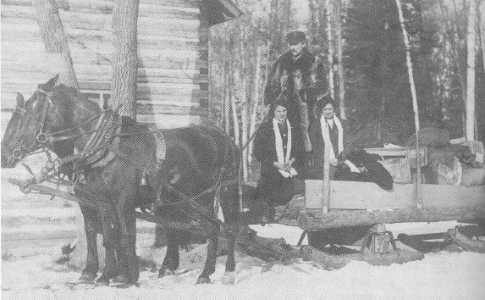
THE MARTIN SCHULERICK PLACE, 1910
Located in eastern Cornish Township
Pictured is Martin Schulerick, Polly and Esther Wiggins
Courtesy of Walter Schulerick
The major settlement of the township occurred in the teens and twenties of this century, 1900's. As the population swelled, Edgar Raveill saw an opportunity to establish a post office for the community. On June 27, 1913, he was appointed the postmaster for the Boot Lake Post Office, which was set up in his home on the north end of Boot Lake. The mail would be carried down from the Jacobson Post Office. "They gave out the mail, sold stamps and made out money orders. The 11:00 A.M. train would come into Jacobson and then the mail would be brought to Boot Lake with horses or by backpack. Ike Nelson was the first mail carrier to Boot Lake. Later on, the mail would be brought by use of a model T Ford. After Ike, Mr. Oranberg, who lived in Turner Township, would bring the mail." (Ibid)
Schools were established early on. The local school district came into effect on March 20, 1906. It was known as District 84 and stayed organized until July 20, 1950, when it merged with the Consolidated School District 4 of McGregor.
The first school was the West Boot Lake School, which was located just west of Boot Lake in section 33. It was a log building, but it is not known for sure just when that building was constructed. It probably was built in 1906. Esther Wiggins was one of the teachers who taught there. "Esther Wiggins closed her school at Boot Lake, Dist. No. 84, with a picnic and outdoor program last week. The following are the names of the pupils receiving diplomas for perfect attendance during the entire year: Louisa Cornish, Kathryn Cornish, Maynard Raveill, George Cornish and Esther Cornish." (Aitkin Age ~ July 1, 1911) The school was used for other activities as well. "Services were held Tuesday evening in the Boot Lake school house, Mr. Lee officiating." (Aitkin Republican ~ May 30, 1918)
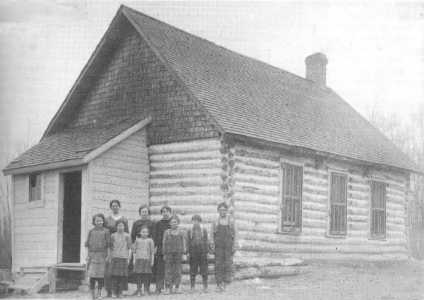
WEST BOOT LAKE SCHOOL, DISTRICT #84
Courtesy of Laurence Coleman
A second school was then built north of Boot Lake in section 27 in 1914. (Per interview with Laurence Coleman ~ August 3, 1995) It replaced the first school and was placed there to be more convenient for the residents and closer to the children. This school lasted until about 1935, when it closed permanently.
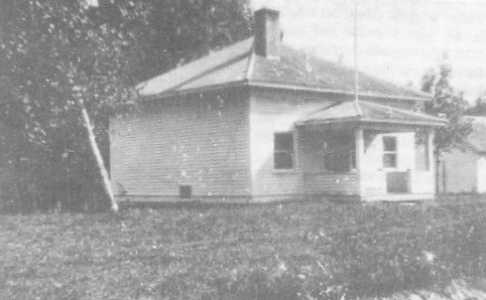
SECOND BOOT LAKE SCHOOL OR NORTH SCHOOL, DISTRICT #84
Sometimes referred to as East Boot Lake School
Courtesy of Laurence Coleman
The West School or Sheets School was built in 1918 and ran until 1936. It was located in section 30. In the 1931-33 school years, the school was closed, and the children were then transported to the Boot Lake School by J. H. Wilson. (Aitkin Age ~ August 19, 1932) Some of the school board members were: Lou Sheets, treasurer; Milo Cornish, chairman; and Edgar Raveill, clerk. Clay Coleman also served as clerk for a few years. (Per interview with Laurence Coleman ~ August 3, 1995)

SHEETS SCHOOL, 1918
Two miles west of Boot Lake
Courtesy of Ida Anderson
In the north half of the township was School District 91. It was organized on January 8, 1907 and stayed organized until June 29, 1951, when it was merged with McGregor. Its only school was the Thompson School, which was also referred to as the Sall School or just simply the Cornish School. This School was built in 1914, and it burned down in 1927. Another school was moved in from over by Hill City. This second school only ran a few years until 1931. It was then made into the Cornish Town Hall, which is still in use to this day. (Per interview with Ida Anderson ~ May 18, 1990)

FIRST CORNISH SCHOOL, 1914-1927
Also known as The Thompson School or Sall School
Courtesy of Ida Anderson
To the east of Cornish Township is the unorganized township of 51/22. There were only a few pioneers living on the west side of the township. They were: Louie LaBrash, Sam Jackson, Erik Hedbom, Ted Thoe, Gus Lundquist and an old bachelor fellow. (Per interview with Dennis Tennison ~ November 21, 1995) For a time the only access for these farmers was to the west. During 1933 and 1934, a road was put through to the east and access was then provided to markets in Floodwood. "....The road spoken of as the Hedbom-LaBrash is to be completed and extended about six miles beyond its present termination. The work is to be done by the CCC's and will connect trunk highway No. 5 with a good graveled road in St. Louis County. This will greatly shorten the distance to Duluth and give the several families who have been almost isolated five miles east of the highway an outlet." (Aitkin Age ~ October 6, 1933) They were about the same distance to Floodwood or to Jacobson. It was quite a distance for these farmers to get to town with a wagon and gorses. One local resident remarked, "I don't know why those people lived out there so far into the sticks." (Per interview with Laurence Coleman ~ August 3, 1995)
Milo Cornish built his place on the east side of Boot Lake. He was interested in bringing the community together to enjoy some recreation, and so he built an open air pavilion. This was used for July 4th celebrations, and the residents would dance in it to music played by local musicians. Henry (Ike) Nelson played the fiddle, and Dick Vansteenburg played the Hawaiian guitar. (Ibid)
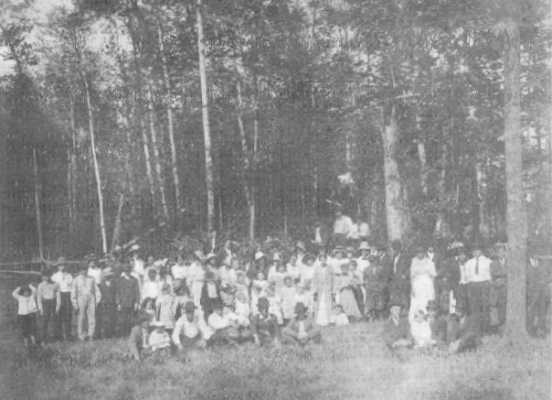
FOURTH OF JULY CELEBRATION
AT THE MILO CORNISH PLACE NEAR BOOT LAKE, 1913
Milo Cornish is standing in the back with suspenders
Courtesy of Laurence Coleman
About 1912, the Johnson brothers came to live in Cornish Township. They bought land next to each other in the northwest part of the township. In 1914, Fred Johnson came. In 1916, he built a sawmill which he ran until it burned down in 1929. (Per interview with Ida Anderson ~ May 18, 1990)

JOHNSON'S SAWMILL, 1920
Courtesy of Ida Anderson
In 1917, the state built Highway 5 through the center of the township. the state set up their camp a mile or so west of Boot Lake for the construction of the highway. The road had been built as far as Boot Lake in 1917, and so for the next year or so, the work was pushed northward. The camp had from 40 to 50 men working out of it. Many of the local men found work on that project. (Per interview with Laurence Coleman ~ August 3, 1995)
In 1926, a major logging operation was set up in the eastern part of the township. Fred Blais of Shovel Lake was a major player in getting out the timber. The ice roads ran from Rathouse and Cutaway Lakes to the south on up along the Cornish Flowage to Jacobson. Ice roads were set up for the steam hauler. John and Frank Robinson were the foremen of the logging venture. Mrs. Frank Robinson was one of the camp cooks. (Per interview with Ida Anderson ~ May 5, 1990)
"Mr. Blais owned the timber on some 160 forties in that vicinity, and having a satisfactory market for only the pine, pulp, cedar, etc., sold the hardwood to the National Woodenware Company. The two concerns are logging the timber jointly, that is, the camps and crews and outfits are entirely separate and distinct, but they are co-operating in using the same roads and maintaining same and in various other ways. Mr. Blais has several camps and about 150 men, most of them working on piece work, and besides he had five jobbers working smaller camps and crews, these latter using the same main logging roads, and drawing their stuff with teams and trucks. Mr. Blais has a ten ton caterpillar tractor and hauls 50 cords of pulp wood at a load. The roads are all ice roads, and the weather of the present winter is reported as being ideal for logging, with the snow not so deep that it is uncomfortable in the woods for cutting and skidding and the weather plenty cold to keep the ice roads in the finest of condition. The timber is being landed at Mississippi Landing, and in the spring will be driven to Aitkin where it will be loaded on cars for its final destination." (Hill City News ~ January 28, 1926)
"The National Woodenware Company is logging entirely hardwood timber for use in its large woodenware plant in Hill City. They are using a steam hauler with trains of ten sleighs, each sleigh carrying between 3,000 and 5,000 feet to a load, or between 30,000 and 50,000 feet to a trip. They are landing on the line of the Hill City Railway Co. and they will load their timber on board cars and ship it to Hill City, a distance of about 25 miles, by rail. The woodenware company has four or five camps with about 115 men employed. They also have some smaller jobbers, most of whom are hauling with trucks.....They are expected to put in the neighborhood of four million feet of hardwood this winter." (Ibid)
The logging operation ran from 1926-28 and created work for many of the local farmers. It was an activity worth viewing. "Mr. and Mrs. John McArdle and family and Miss Hawkinson visited at the woodenware camp Sunday afternoon, where they were pleasantly entertained. This is a very busy time at this camp as the water tanks are being put over the roads night and day, watering the ruts making ice roads over which enormous loads of logs will be hauled to the Mississippi Landing with a steam hauler. This steam hauler sometimes pulls a load of twelve or thirteen sleds. Each sled holds from one hundred to one hundred and fifteen logs." (Aitkin Age ~ December 17, 1927)
The farmers did well throughout the teens and twenties. "The potato digging and picking 'Bee' has completed its work for the season. Amel Anderson with his digger and a bunch of pickers including Clarence Anderson, L. H. George and Arthur Sheets, Lloyd and Edwin Cornish, Gust Bucholz, Maynard Raveill and John McArdle made quick work of the potatoes and the ladies not wishing to be cheated out of the excitement busied themselves preparing big dinners for the workers. A general good time was enjoyed. The pickers, however, declared they are glad they are done and are now busy getting their bended, stiff backs into normal condition." (Aitkin Age–October 22, 1927)
Livestock also proved to be profitable. "Arthur Sheets has been busy with his truck for a few days this week hauling sheep and other stock to Palisade for the farmers here who ship through the Palisade Shipping Association." (Aitkin Age–October 29, 1927)
Roads were constructed early on, but it seemed they always needed work. In section 27, the road sand or "turned over" and caused some hardship.
A form of socializing was needed for the children of Cornish. "A 4-H Club is being organized in this community under the direction of county agent (Christ) Nash. Those who have signed up are: Edwin and Leighton Cornish, Wayne Raveill, Verle Powell, and Kenneth and Marcella Coleman." (Aitkin Age–May 9, 1930) The effort was met with much enthusiasm. "....Seven boys and girls joined and it is expected that more will sign up before the next meeting. The following officers were elected: Edwin Cornish, president; Marcella Coleman, vice-president; Josie Sheets, secretary-treasurer; Mrs. John McArdle was appointed leader. Quite a number of grown-ups, who are interested in the boys' and girls' success in this undertaking, were present and all enjoyed the meeting immensely." (Aitkin Age–May 16, 1930)
Ralph Sharp had a cabin on Cutaway Lake that was fairly large for its day. He enjoyed entertaining his friends there. "Ralph Sharp of Minneapolis gave a house warming party in the form of an old time dance Saturday night at his new cabin on Cutaway Lake. Over fifty of the Boot Lake and Verdon neighbors were present and enjoyed a most sociable time. The music was furnished by Elmer Moore, Martin Schularic, and Dick Wiggins. M. F. Cornish acted as floor manager and all present participated in the old time dances until an early hour and all agreed that Mr. Sharp is a most delightful host." (Aitkin Age ~ July 29, 1932)
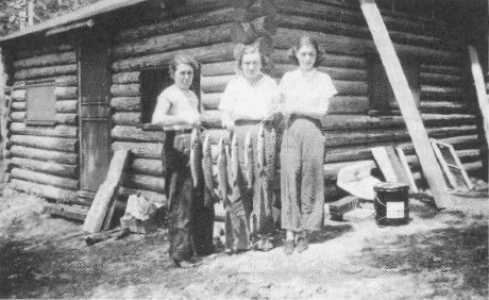
TELLETS RESORT, JUST NORTH OF CORNISH TOWNSHIP, 1938
Pictured are Louise Didden and Laura Kellet
Courtesy of Chuck Hegg
In 1954, the old Olav Nielsen place on the west side of Boot Lake was purchased by an organization called "The Frontiersmen." (Per deed record #93 dated 5/31/1954, Aitkin Co. Recorder's Office) The organization was a group of adult scouters who built a camp on the site to be used for outdoor learning activities by Boy Scout groups and other youth organizations. (Per letter from Mike Hodges dated November 27, 1995) A bunkhouse and other buildings were built along with a dock for fishing and swimming facilities. A beautiful view across the lake could be had from the vantage point of the camp. The camp has been enjoyed by many over the years.
On August 9, 1969, a major tornado hit the northern part of Cornish Township. "Disaster struck here with unbelievable fury early Wednesday evening, when a tornado struck the Carl Swanson, Erick Hillstrom, John Dahl, Edwin Swanson (new lake home), Eino Oberman and Glen Nylanders, and doing much damage at the Earl Tennisons. John Dahl was killed, otherwise no one sees to have been hurt. But there is such a tangled mess of trees and broken buildings. Blandin Paper Company lost timber on their properties and many others lost small buildings, etc.....Dahl, 75, was killed when his dwelling was lifted from its wood block foundation and shattered at the foot of his hilltop home site. He was Aitkin County's only known tornado casualty." (Aitkin Age ~ August 13, 1969) The tornado had run along the Mississippi River for a distance, and so after the storm, there were fish and turtles all over the Hillstrom farm where they had been dropped. (Per interview with Ed and Vera Simons ~ February 15, 1993)
The years have slowly slipped away. There has been some development and cabins have been built along Ball Bluff and Blackface Lakes. Much of the township has reverted to timbered lands with a few farms scattered throughout the township. Presently, most of the population is in the northwestern part of the township along Highway 65 and County Road 10. The lakes are known for good fishing, and timbering is once again playing a major factor in the economy of the local people.

BACK
HOME